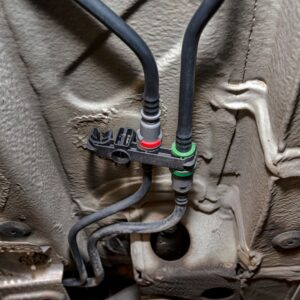Many drivers know the difficulty of owning a vehicle during harsh northern winters. Driving over slippery roads is one thing, but a frozen fuel line is another.
Some drivers might blame this issue on frozen gasoline, but is that really the case? If so, at what temperature does the gas go from liquid to solid, and how does it affect vehicle performance?
Can Gasoline Freeze?
Gasoline can freeze at extremely low temperatures. If you’ve ever seen a slightly leaking fuel line on a vehicle in winter weather, the evaporating fuel that is leaking out of the line will multiply the cold while driving due to wind chill and the latent heat of vaporization. So you may see frozen gasoline after driving in very cold weather at a leak point where the gas is exposed to the wind as you drive.
This means gasoline won’t be frozen solid under normal winter conditions. Rather, it crystalizes and causes clogged fuel lines or filters. Unlike water, gas doesn’t completely freeze over.
The hydrocarbons in gasoline will instead slow down and harden but won’t form a new state of matter. Unlike water, it won’t go from liquid to solid if exposed to low temperatures.

Before it freezes, gasoline starts to gel, making it difficult for fuel pumps to work effectively, especially when there’s any amount of water in the tank from condensation.
If you’re dealing with cold weather, make sure to keep your gas tank at least half full to avoid condensation, which can freeze and cause problems.
Modern fuel pumps are mounted so that the fuel inlet is spring-loaded against the bottom of the tank. That way, water accumulation from condensation will be dealt with early and in very small amounts rather than allowing it to accumulate like it did on older vehicles.
What Temperature Does Gasoline Freeze?
Depending on the type and its components, the freezing point of gasoline is between -40 and -200 degrees Fahrenheit, with most freezing at -100 degrees.
This means you don’t have to worry about the gasoline freezing. Instead, the fuel lines should be your concern. The fuel line is the pipe or hose that transports fuel from the fuel tank to the engine. As mentioned, cold environments can clog the line and negatively affect performance.
Effects of Cold Weather on Gasoline
Besides a frozen fuel line, cold temperatures can also reduce fuel efficiency. There are a handful of reasons this happens, namely the following:
Engine Runs Richer Longer When Cold
Fuel efficiency drops during the winter because the engine has to run richer longer, and then there are extended warm-up times that use fuel simply to warm up the interior on vehicles with remote start.
An engine that runs “richer” refers to the fuel mixture. More gas is injected into the engine when it’s cold, resulting in reduced fuel economy. Fortunately, this issue isn’t too serious because it improves once the engine warms up.
Even fuel-injected engines need more fuel when cold. Carbureted engines had a choke; fuel injected engines receive more fuel as commanded by the PCM/ECM. Keep in mind there’s also more oxygen per cubic inch of cold air than there is in hot air.
Winter Gas Burns Faster
If you’ve been using winter mix for gasoline, you might notice reduced fuel economy. These mixtures have additives that let them burn faster for easier starting. However, they also reduce gas energy, which lowers fuel economy.
Thicker Lubricants
Lubricants also thicken when cold, thus increasing drag on the moving parts, but this is only an issue when first starting. As the engine warms up, the lubricants get thinner.
But this potential issue makes parts harder to turn, resulting in more energy spent to move them. This situation burns more gas, which could result in poor fuel economy.
Again, like an engine running rich, the issue won’t persist once you drive your vehicle for a few minutes because the engine warms the lubricants up.
Lower Tire Pressure
Tires also lose pressure when driving during winter because the cool air is dense. This means your vehicle has to work harder to maintain momentum, which results in decreased fuel efficiency. So always ensure your tires are inflated properly before heading out for a drive.
Signs of a Frozen Fuel Line
Some signs of a frozen fuel line include engine sputtering, difficulty starting, and engine issues before and after ignition.
Engine Sputtering
An engine that shakes and produces a knocking sound is sputtering. This occurs when there are issues with the fuel delivery system, resulting in a lean fuel mixture in the combustion chamber.
Ice forms inside when the fuel line freezes, which leads to sputtering. The frozen gasoline also creates a thick liquid that can clog the fuel filter, resulting in sputtering.
Failure to Start
If the fuel lines aren’t completely frozen, a small amount of fuel may still reach the engine. However, it might not be enough for the engine to start because it needs a certain amount of fuel before igniting.
Engine Won’t Start But Will Spin
A completely frozen fuel line means no fuel reaches the engine, meaning it will spin but won’t start at all.
Engine Stopping After Starting
Lastly, your engine might also stop after momentarily starting if the fuel line is frozen. This is due to buildups blocking the fuel from reaching the engine. The difference between this scenario and failure to start is how much fuel reaches the engine.
How to Thaw a Frozen Fuel Line
The safest way to thaw a frozen fuel line is to start the vehicle and have the engine heat gradually thaw out the line. This method typically takes more than an hour, but it’s the easiest and safest way to thaw frozen lines because it doesn’t use any chemicals.
If you’re in a hurry, you can also have the vehicle topped up to remove cold air from the tank or visit an auto parts store to get some fuel treatment antifreeze.
How to Prevent Frozen Fuel Line
To prevent a frozen fuel line, you can warm the vehicle up, drive it often, use a fuel stabilizer, and keep the tank filled.
Warm Vehicle Up
Warm your vehicle up before using it to thaw and prevent frozen fuel lines. Start your engine and let it sit for several minutes to allow the fuel and engine to heat up. This also decreases the chances of stalling and sputtering.
Use Vehicle Often
Similarly, using your vehicle often prevents gas from staying in the fuel tank long. A simple trip to a local store or around the block will help circulate the gas in the system.
Use Fuel Stabilizer
You can also add a stabilizer to the gas tank to keep the fuel from coagulating. Read the directions before using the stabilizer to ensure it works properly. If you can, get the recommended stabilizer for your fuel type, so it’s best to ask a mechanic before buying.
Keep Tank Filled
Lastly, try to keep the fuel tank filled at least one-quarter since smaller amounts of liquid are more affected by cold temperatures. Keeping it filled also prevents you from getting stranded.
Where to Get a Replacement Fuel Line that Fits Your Car
If your vehicle’s fuel lines are damaged after the cold winter months, you’ll need to have them repaired as soon as possible. In some cases, it’s better to replace them altogether. However, finding just the right fuel line for your vehicle can be a pain, especially if your local auto parts shops don’t have any on hand. So why not try searching on CarParts.com?
CarParts.com aims to help you order online with confidence. That’s why we have a built-in vehicle selector that applies to all our products site-wide. Simply input your vehicle’s make, model, and year to view compatible fuel lines. Our 60-day return policy is also in place in case anything’s wrong with your new parts when they reach you. We’ll give you your money back if you aren’t completely satisfied!
Get your vehicle back on the road after your winter mishaps. Order a new fuel line from CarParts.com now.
Any information provided on this Website is for informational purposes only and is not intended to replace consultation with a professional mechanic. The accuracy and timeliness of the information may change from the time of publication.





















